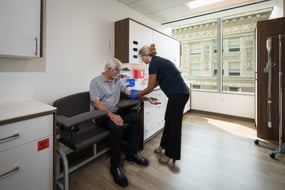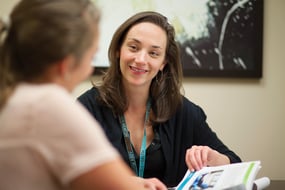COVID-19 is front and center in the news 24/7. It has also transformed how all of us are living our lives, for the time being at least. With this flood of information, it can be difficult to understand what information to trust. We want to help you with that.
This week we sat down with our Medical Director, Dr. Sarat Raman, to discuss how COVID-19 is spread, what you can do to keep yourself safe, and how Vera is responding to the crisis.
How is COVID-19 transmitted?
“We’re learning more and more every day about how the disease is transmitted. Right now, the evidence largely points towards a droplet-based transmission. This is why there’s such an emphasis right now on cleaning high-touch areas and other surfaces. There’s also recent research that shows person-to-person transmission through the air is more possible than we previously thought.”
What are the symptoms?
“It's an evolving piece, much like the other information. This is also information that's changing. The initial symptoms that we're seeing in the majority of people are fevers, shortness of breath or difficulty breathing, and coughing. But we're starting to see some other things.
“The lack of smell and taste is a new potential symptom that we're seeing. So if your sense of smell just goes, that might be an indication that COVID-19 is something that you've contracted.
“It’s important for patients to have an awareness of the pattern of symptoms. There are different kinds of patterns that we’re seeing but there are two concerning patterns people should be aware of.
- Some patients will have mild to moderate symptoms for about a week, and then all of a sudden that will crash out. They'll get a lot worse. That's why we want people to make us aware of when their symptoms begin and to check back in on a regular basis.
- Just because there are higher risk categories, like patients who are over 60 and those who have chronic conditions, that doesn't mean that people who are younger cannot get COVID-19. We are starting to see a rise in the number of people that are younger than 40 who are getting this condition and having some more significant versions of the disease. So they're also getting sicker and hospitalized.”
How has Vera shifted the way they're providing care in response to COVID-19?
“As everyone should hopefully know by now, the greatest protection our patients can have from COVID-19 is isolating themselves from other people who may have the conditions.
“We’ve moved to phone-based and virtual visits for most routine care. Phone-based visits tend to be shorter, so we’re actually available to more patients than we were before, which is great.
“If you do need to see a provider in person, we've divided our days into split days. In the morning, we bring in people who have conditions that need exams and labs and things that are not infectious. So if you fell or, I don't know, injured your knee and we really need to examine your knee, for instance, that would be a person who would come in the morning. Whereas in the afternoon we're bringing in all of our coughs, colds, and suspected COVID-19 cases. We are testing for COVID-19 at most of our sites, but not all.”
Who should get tested?
“So there's some groups of people for whom testing should be strongly considered:
- The most important is people that have symptoms. The most common are fever plus cough and/or dyspnea, which is shortness of breath or difficulty breathing. Someone with one to three of those constellation of symptoms.
- Next come high-risk patients: Patients over 60, patients with chronic medical problems, patients who are pregnant and these are all people who have higher risk for complications from COVID-19. These are people who could more easily move on to hospitalization, pneumonia, some other concerns like that.
- Beyond that, first responders or healthcare workers, public safety workers, central workers for the infrastructure of the city should be strong candidates for testing.
- Patients with mild symptoms that are generally healthy probably do not need testing
“If we had testing available for everybody, we would say, ‘We want to test everybody’ and figure out who does have it and who doesn't have it, and separate the two. But unfortunately, the restrictions are really coming in because we have a short supply of the testing supplies and the testing capacity.”
How can someone get tested?
“Number one, you need to call your primary care provider and/or call us at Vera if you use us or have access to us, and even if you don't consider us your primary care provider.
“Based on that, we can either bring you into our care centers and have you tested at one of those or we can direct you to other local resources that are available. We can guide you to hopefully what's going to be the quickest and easiest method for you to get tested.”
What can people do to protect themselves and their loved ones?
“The number one thing that we talk about is home isolation. We really want to make sure patients are not gathering in crowds and not being around people. The general guidance is being at least six feet from people. That's usually the distance that we recommend for sneezes and coughs. And so you don't want to be caught by somebody else's sneeze or cough.
“Number two, wash your hands. We can't stress it enough. Some of the biggest concerns are that we all have a natural tendency to touch our own faces with our hands. And so the concern is that you will touch something that's got the virus with your hands and then touch your face. And if the virus gets on any of what we call your mucus membranes in your mouth, in your nose, your eyes, that's the way of contracting the virus.
“A few other quick ones are:
- Don’t share household items like toothbrushes or food.
- Clean high-touch surfaces like doorknobs, keyboards, and computers every couple days.
- Monitor for symptoms and call someone as soon as they appear.”
If you want to learn more about how to practice whole health at home, visit our resource page. To stay on top of the latest information about the virus, you can visit our COVID-19 (Coronavirus) Advisory Page. We’re keeping it constantly updated.
Sign up
Join our email list to receive the latest open positions, Vera Careers news, and more.







